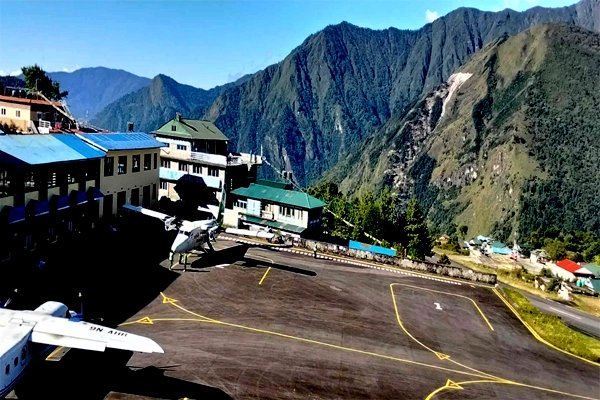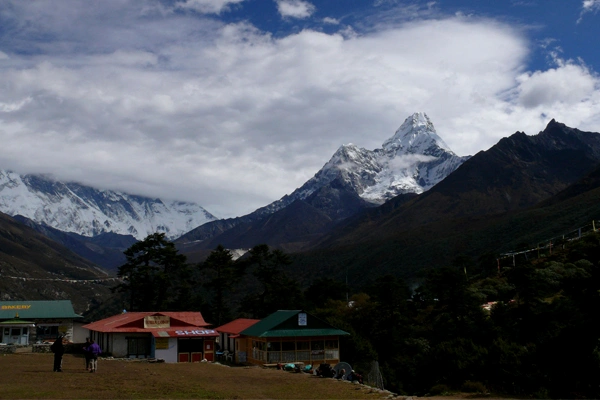If you're planning to embark on the Everest Base Camp Trek in October, then it is an exceptional time to undertake this exhilarating adventure.
Nestled amidst the towering peaks of the Himalayas, the Everest Base Camp Trek offers an awe-inspiring journey that draws adventurers from around the world. At an elevation of 5,364 meters (17,598 feet), Everest Base Camp serves as the launching point for mountaineers aiming to conquer Mount Everest, the crown jewel of the Himalayas. However, for trekkers, reaching this legendary destination is a remarkable achievement in itself. The trek presents an opportunity to immerse oneself in the raw beauty of the Khumbu region, passing through picturesque Sherpa villages, enchanting rhododendron forests, and breathtaking glacial valleys.
Why Everest Base Camp Trek in October?
As autumn takes hold of the Everest region, the trails come alive with vibrant hues of golden and red as the foliage starts to change. The weather during October is generally stable, allowing for excellent visibility of the surrounding peaks, including the legendary Everest herself. The breathtaking vistas of Ama Dablam, Lhotse, Nuptse, and countless other majestic peaks will leave you awe-struck, creating memories to last a lifetime.
Moreover, October attracts a diverse community of trekkers from across the globe, creating a vibrant atmosphere along the trail. The tea houses and lodges en route offer warm hospitality and provide comfortable accommodations, ensuring a pleasant trekking experience. As you traverse the well-established trails, you'll have the chance to interact with fellow adventurers, exchange stories, and forge lifelong friendships.
With its clear skies, mild temperatures, and relatively dry weather, Everest Base Camp Trek in October offers trekkers a remarkable experience amidst the mesmerizing Himalayan landscape.
Besides this here are the major reasons to trek Everest Base Camp in October.
Peak Trek Season:
October entices trekkers with its stunning weather, making it the preferred time for many to undertake the hike to Everest Base Camp. The trails and lodges buzz with activity as adventurers take advantage of the favorable conditions. Avoiding high-altitude treks during inclement weather, trekkers flock to Everest in October, ensuring a greater chance of clear views and comfortable hiking. The dry trails, vibrant forests, and colorful blooms along the route enhance the trekking experience, leaving a lasting impression on those who traverse them.
Flowering Flora-Fauna Vegetation:
In October, the Everest Base Camp Trek reveals a remarkable display of flowering flora and fauna, creating a visual symphony that captivates trekkers along the trail. As you venture through the Khumbu region, you'll be greeted by a vibrant landscape adorned with a plethora of colorful blooms and thriving wildlife, adding an extra layer of enchantment to your journey.
The lush vegetation showcases an array of beautiful flora, including rhododendrons, magnolias, primulas, and a variety of alpine wildflowers. These delicate blossoms transform the landscape into a kaleidoscope of reds, pinks, purples, and yellows, providing a stunning contrast against the rugged terrain.
As you immerse yourself in the beauty of the flowering flora, you'll also have the chance to spot a diverse range of fauna that call the Everest region home. Keep your eyes peeled for the elusive musk deer, the Himalayan tahrs gracefully perched on cliffs, and the playful antics of Himalayan monals, also known as the Danphe, Nepal's national bird. Along the trek, you might also encounter soaring eagles, Himalayan pheasants, and various other bird species, adding an element of avian charm to your adventure.
Gorgeous Weather and Incredible Mountain Views:
One of the many reasons October stands out as a prime time for the Everest Base Camp Trek is the combination of gorgeous weather and breathtaking mountain vistas that await trekkers. This month offers an unparalleled opportunity to witness the Himalayas at their majestic best, creating an unforgettable visual feast along the entire trekking route.
As the autumn season settles in, October boasts clear skies and mild temperatures, making it an ideal time for outdoor adventures. The weather conditions during this month are generally stable, with lower chances of precipitation and reduced cloud cover. This means trekkers can enjoy excellent visibility, providing uninterrupted views of the towering peaks that surround the Everest region.
The clear October weather allows the sunlight to illuminate the mountains, casting dramatic shadows and revealing the intricate details of the rocky terrain. The play of light and shadows on the snow-capped summits creates a mesmerizing visual spectacle, showcasing the grandeur and raw beauty of the Himalayas in all their glory.
The Warm Hospitality & Sherpa Cultural Exploration:
Beyond the breathtaking landscapes and exhilarating adventure, the Everest Base Camp Trek offers an opportunity to immerse yourself in the warm hospitality and rich Sherpa culture of the Himalayas. As you journey through the Khumbu region, you'll be embraced by the genuine kindness of the local Sherpa people, creating a truly enriching experience along the trail.
October offers an incredible opportunity to delve into the ancient Buddhist monuments, vibrant culture, and unique customs of the Sherpa community along the Everest Base Camp Trek. By engaging with knowledgeable English-speaking trek guides, you can gain profound insights into Sherpa traditions, even when faced with language barriers. Prioritizing the selection of a local trek guide before embarking on your Everest base camp tour ensures a more meaningful and enriching experience. With Nepal Spirit
Adventure's expert guides, you'll receive in-depth information in a friendly environment, fostering a deeper connection with the Sherpa culture throughout your journey.
Weather and Temperatures of Everest Base Camp in October
During October, the average daytime temperatures at lower altitudes, such as Lukla (2,860 meters/9,383 feet), range from around 10 to 15 degrees Celsius (50 to 59 degrees Fahrenheit). As you ascend to higher elevations, including Namche Bazaar (3,440 meters/11,286 feet) and Tengboche (3,860 meters/12,664 feet), temperatures can drop to approximately 5 to 10 degrees Celsius (41 to 50 degrees Fahrenheit) during the day.
While the days offer mild and pleasant weather, it's important to note that the nights and early mornings can be considerably colder. At higher elevations, temperatures can dip below freezing, ranging from -5 to -10 degrees Celsius (23 to 14 degrees Fahrenheit). It is crucial to be well-prepared with warm clothing and proper gear to stay comfortable and safe throughout the trek.
In terms of weather patterns, October is characterized by clear skies and relatively low chances of rainfall. This translates to excellent visibility of the surrounding mountains, including the legendary Mount Everest. The absence of heavy cloud cover allows trekkers to witness the breathtaking panorama of snow-capped peaks and deep valleys in all their glory.
The combination of mild temperatures, clear skies, and limited rainfall creates an optimal environment for trekking and offers trekkers ample opportunities to enjoy the incredible mountain views that the Everest region is renowned for. Whether it's the first light of dawn illuminating the summit of Everest or the golden glow of sunset casting a spellbinding aura over the Himalayan peaks, October presents trekkers with an extraordinary visual spectacle.
General Tips for the Everest Base Camp Trek in October
Embarking on the Everest Base Camp Trek in October is an exciting endeavor, offering optimal weather and breathtaking views. To make the most of your adventure, here are some general tips to keep in mind:
Plan Ahead: Make sure to book your trek well in advance, as October is a popular month for the Everest Base Camp Trek. This ensures the availability of flights, accommodations, and necessary permits.
Pack Wisely: Pack layers of clothing to accommodate the varying temperatures. Include warm layers for chilly mornings and evenings, as well as lightweight and breathable clothing for the daytime. Don't forget essentials like sturdy hiking boots, a waterproof jacket, sunscreen, a hat, and sunglasses.
Physical Fitness: Prioritize your physical fitness before the trek. Engage in regular exercise, including cardiovascular activities and strength training, to build stamina and endurance. Consult with a healthcare professional for any specific fitness recommendations.
Acclimatization: Allow time for acclimatization to the high altitude. Follow a gradual ascent, take rest days, and hydrate properly. Listen to your body and communicate any symptoms of altitude sickness to your trek guide immediately.
Stay Hydrated and Nourished: Drink plenty of water throughout the trek to stay hydrated. Carry water purification tablets or a filtration system. Maintain a balanced diet, focusing on nutritious meals to keep your energy levels up.
Trek with a Guide: Consider hiring a knowledgeable local trek guide who can provide insights into the region's culture, history, and natural wonders. A guide ensures your safety and enhances your overall trekking experience.
Respect the Environment and Culture: Preserve the pristine beauty of the Himalayas by adhering to responsible trekking practices. Respect the local customs, traditions, and religious sites along the route.
Stay Connected and Prepared: Carry a fully charged mobile phone and a power bank for emergencies. Familiarize yourself with emergency evacuation procedures and have a basic first aid kit on hand.
Stay Positive and Enjoy the Journey: Embrace the challenges and rewards of the trek with a positive mindset. Take time to appreciate the stunning landscapes, interact with fellow trekkers, and create lasting memories.




